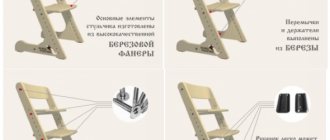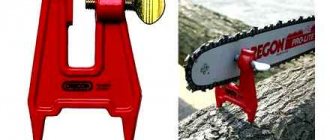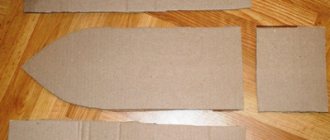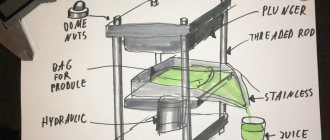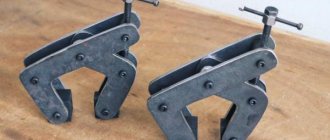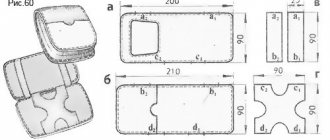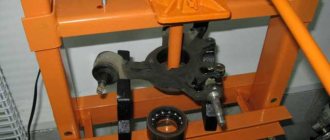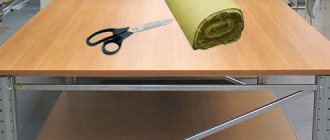DIY children's desk drawings
DIY children's desk, drawings, description and order of its assembly.
The proposed model will be able to serve your child for a long time until high school. If your child has gone to school, then you are faced with the acute question of choosing a desktop or desk for his normal development. Correct posture and reducing eye strain require an individual approach when choosing a workplace that can adapt to the growth of each student.
Side view (maximum table extension)
Side view (minimum table extension with table top rotation)
Why children's tables are special
The importance of the correct layout of children's workplaces has long been known. The individual characteristics of the child’s body structure require an individual approach, which mass production often cannot do - you have to take the solution to the problem under personal control
You will find a lot of useful information in GOST 5994–93: it contains a table divided into 4 height groups of children, where the key dimensions and slope angles of surfaces are indicated. But, since the home desk will be used without replacement, starting from preschool age and at least through the 5th–6th grade, it simply must be able to be adjusted as the child grows
We also draw attention to the importance of rounding corners on all protruding parts with a radius of 10 mm or more
| Size name | Sizes depending on the child's height | |||
| 1000–1150 | 1150–1300 | 1300–1450 | 1450–1600 | |
| Working plane height h1, not less | 460 | 520 | 580 | 640 |
| Distance from the floor to the lower edge of the elements protruding under the lid of the desk at its edge (height of the legroom) h2, not less | 350 | 410 | 470 | 530 |
| Distance from the floor to elements protruding above the knees (height of space for legs bent at the knees) h3, not less | 350 | 350 | 400 | 400 |
| Distance from the floor to elements protruding above the foot of a seated person (height of space for outstretched legs) h4, not less | 250 | 250 | 300 | 300 |
| Working plane width t1, not less | 450 | 500 | 500 | 500 |
| Length of working plane b1, not less: | ||||
| single desk | 600 | 600 | 600 | 600 |
| double desk | 1200 | 1200 | 1200 | 1200 |
| Distance between the supporting elements of the desk (width of the legroom) b2, not less than: | ||||
| single desk | 420 | 420 | 420 | 420 |
| double desk | 1020 | 1020 | 1020 | 1020 |
| Distance from the edge of the desk on the side of the seated person to the elements protruding in front of his knees (depth of legroom) t2, not less | 300 | 300 | 300 | 350 |
| Distance from the edge of the desk on the side of the seated person to the elements protruding above his foot (depth of legroom when sitting with legs extended) t3, not less | 400 | 400 | 400 | 400 |
| Seat height h5 | 260 | 300 | 340 | 380 |
| Seat depth h4 | 240 | 260 | 280 | 300 |
| Seat width (one seat) b3, not less | 250 | 270 | 290 | 320 |
| Height of the back bend line w, no more | 160 | 170 | 190 | 200 |
| Height of the lower edge of the backrest above the seat h6 | 120 | 130 | 150 | 160 |
| Height of the upper edge of the backrest above the seat h7 | 250 | 280 | 310 | 330 |
| Backrest width (one seat) b4, not less | 250 | 250 | 250 | 280 |
| Bend radius of the front edge of the seat r1 | 20-50 | 20-50 | 20-50 | 20-50 |
| Radius of the backrest (one seat) in terms of r2, not less | 300 | 300 | 300 | 300 |
| Seat tilt angle g, degrees | 0-4 | 0-4 | 0-4 | 0-4 |
| Backrest tilt angle ß, degrees | 95-106 | 95-106 | 95-106 | 95-106 |
| Distance from the edge of the table on the seated side to the most protruding part of the back t5 | 220 | 240 | 260 | 280 |
| Distance from the edge of the table on the seated side to the front edge of the seat t6 | -40 | -40 | -40 | -40 |
Most manufacturers also make a very serious mistake - applying bright images and inscriptions to the surface, using compositions with excessively high color contrast.
The last point is the organization of study and work space. Since the child does not need visibility in front of him (usually in a nursery the desk is leaning against the wall), this space can and should be used to build an organizer. And, as you will see later, not every layout will be successful.
The presented model allows:
- adjust table height from 570 to 720 (mm), adjustment step is 50 (mm)
- adjust the table tilt angle from 0° to 90° (the maximum angle is set theoretically), the adjustment step is 5°
Recommended tilt settings:
— drawing from 0° to 5° — writing from 10° to 15° — reading from 20° to 30°
Components of a children's desk:
We will make it from planed boards. From the inside of the guide board, at the end we mill a groove measuring 10x10 (mm). The sharp edges of the parts are rounded. We fasten the parts of the legs together using:
We attach the top shelf and the footrest to the legs with wood screws or confirmations.
We will make it from planed boards. From the outer sides of the guide board, at the end we mill grooves along the edges measuring 10x10 (mm). We drill through holes with a diameter of 20 (mm) in the center.
We will make it from laminated wood or plywood. We will make the rotating mechanism from sheet metal 2 (mm) thick and attach it to the tabletop with wood screws. Alternatively, it can be made from wooden blocks.
1.
We insert the lifting mechanism into the grooves of the base.
2.
We secure the tabletop to the lifting mechanism using pins, washers and M8 nuts.
DIY children's desk assembled. Using the proposed concept for designing and constructing a structure, you can modify and supplement the model yourself with various shelves, pencil cases and glasses for stationery.
Source
Master class: how to make doll school furniture from cardboard
Materials and tools:
— sheets of A4 size office paper (for printing templates); — packaging corrugated cardboard (3 mm thick); - standard (stationery) knife; — creasing tool; - metal ruler; - scissors; - double sided tape; - Moment Crystal glue, toothpick; - hot glue gun (optional).
As you can see, the materials needed to make doll furniture from cardboard are more than affordable. Getting packaging corrugated cardboard is now not at all a problem: you can find something at home in the pantry or on the mezzanine, huge quantities of used boxes are recycled in furniture and grocery stores - and there you can quite get the necessary amount of cardboard, and for free.
You can also inexpensively buy corrugated cardboard sheets individually at craft stores, packaging stores, or directly at a cardboard factory (if you have one nearby). In this case, I recommend choosing three-layer corrugated cardboard brand T-24
- it's denser. But in principle, softer cardboard of the T-23 brand is also suitable.
The process of making furniture for dolls, like all our cardboard toys, begins with preparing templates.
Generally speaking, having familiarized yourself with the technology itself, you can, if you wish, design doll furniture according to your dimensions.
Or you can use ready-made templates, carefully calculated and tested in practice. A set of templates for making doll furniture “Playing at School” can be ordered from.
PREPARATION OF TEMPLATES
So, if you took advantage of our offer, print the templates on sheets of A4 office paper.
Cut out small templates (which fit entirely on an A4 sheet) with small allowances.
Glue large templates according to the composition diagrams (see example). And also cut with small allowances.
Place pieces of double-sided tape on the back of the templates. Then each template must be attached to the back
side of the corrugated cardboard.
Note:
The templates have a special round icon indicating the recommended direction of the waves of the corrugated layer. That is, the lines inside this icon should be approximately parallel to the lines that are visible on the wrong side of the cardboard.
It is not necessary to follow this direction exactly. Sometimes you have to adjust to the size of an existing piece of cardboard.
Just keep in mind that a cut made transverse to the direction of the waves of the corrugated layer will be stronger and more rigid. And, conversely, a cut made along the waves wrinkles easily.
Therefore, you need to try to ensure that, if possible, all the edges of the parts are exactly across the waves. In addition, they will look more aesthetically pleasing.
Well, now you can proceed directly to making doll furniture with your own hands. Let's start by making a chair and a table.
TEACHER CHAIR FOR DOLLS
Using a standard (stationery) knife, we cut out the parts of the chair S-4.1
,
S-4.2
,
S-4.3
and
S-4.4
. Long straight lines are cut using a ruler, short and curved sections are cut by hand.
On detail S-4.1
Use the tip of a knife to mark the fold lines (before cutting out the part). Having cut out the part, we crease it. A creasing stick used in scrapbooking is suitable for this operation. You can also score with the end of a flat-head screwdriver or scissors (you just need to act carefully so as not to tear the cardboard: the tool must be tilted as close to the surface of the cardboard as possible).
Carefully bend part C-4.1
.
Cutting out parts C-5.1
,
S-5.2
,
S-6
. There is no need to score anything here. And we will make the folds on the parts in the following way: along the blue lines on the template, we will make cuts to approximately half the thickness of the cardboard (be careful not to cut through), and then separate 2 layers of cardboard in the areas between the cut lines.
To make the layers easier to separate, first bend the piece outward along the score lines. In the end it should look like this.
The chair parts are ready. Let's start assembling.
Glue the part C-5.2
inside part
C-5.1
with Moment Crystal glue. It is enough to apply glue along the edges and around the holes. To prevent excess from leaking out, spread the glue with a toothpick into a thin layer.
Glue the second part of part C-5.1
- it turned out to be the seat of a chair.
Glue the halves of part C-6
(the back of the chair). At the same time, we apply glue to single-layer areas.
Place the glued parts under a press for a short time (for example, several books) for a reliable connection.
Notice how neat and precise the end of the seat turned out - this is due to the fact that in this area we separated 2 layers of cardboard.
Inside part C-4.1
First glue part
C-4.2
, then
C-4.3
and
C-4.4
with the right sides facing out.
Check: when bending the chair legs, the specified parts must fit together exactly at right angles.
When the chair legs are dry, glue them to the seat. Pour glue into the slots of the seat, and use a toothpick to lubricate the protrusions on the legs. We connect the parts as shown in the photo.
Glue the back of the chair. Here, in addition to the protrusion and slot, we also lubricate the back surface of the legs with glue.
We connect everything, press and hold until the glue sets.
The cardboard doll chair is ready.
TEACHER'S TABLE FOR DOLLS
Now let's figure out how to make a table for a doll.
Cut out parts C-1.1
and
S-1.2
: 2 pcs. with slots and 1 pc. - without slits.
Cut out 2 parts C-2
and tabletop parts
C-3.1
and
C-3.2
.
Glue the doll table supports using Moment Crystal glue: 1 piece C-1.1/C-1.2
without slot + 2 parts
C-1.1/C-1.2
with slots. In this case, the parts must be positioned so that on both sides of the support the cardboard is facing out.
We also glue the cross member.
And we glue the tabletop: first we glue part C-3.2 inside part C-3.1, then we bend and glue the free halves. Don't forget to apply glue to single-layer areas as well.
The table elements are ready. Assembling: glue the supports and crossbar, then glue the tabletop. For this operation, you can use a hot glue gun. It will be faster and stronger this way.
That's all. The doll table is ready!
Let's move on to the next piece of doll school furniture.
SCHOOL DESK FOR DOLLS
Using the templates, we cut out the parts of supports P-1.1
and
P-1.2
(2 pieces each),
P-2.1
and
P-2.2
(1 piece each),
P-3
(2×3 pieces).
To speed up the process, repeating parts can be cut in 2 layers
: Place 2 pieces of cardboard with right sides facing each other and secure the edges with pieces of masking tape. In this case, you will not need to print additional templates.
But cutting in 2 layers requires more effort. Therefore, if this method turns out to be inconvenient, it is better to cut all the parts in 1 layer. It will be more careful.
Cutting out the details of the bench P-5.1
and
P-5.2
,
P-6.1
and
P-6.2
. Don’t forget: we only make cuts along the blue lines, then separate the 2 layers of cardboard between them.
We cut out the details of the crossbars for the desk P-7
and
P-8
- 3 pcs.
Using the P-8 template, you need to cut out 3 parts, slightly different in size (3 parallel lines are drawn along one long edge of the template). You can do this as follows:
- attach the template to the cardboard and use the point of a compass (or a sewing needle) to mark all the corners of the part along the outer contour;
- transfer the template to a free section of cardboard and mark the corners of the part with the point of a compass, but now using the middle of 3 parallel lines along one long edge;
- transfer the template again and mark the corners of the smallest part.
Mark with a pencil which part is which and where the top is, so you don’t get confused later when gluing. The differences in size are necessary so that the upper end of the crossbar is at an angle corresponding to the inclination of the desk top.
In addition, we cut out the details of the base of the desk P-9
(6 pcs.). The photo shows parts with rounded corners (although on the templates all corners are straight - for ease of cutting). If you wish, you can do this too. To do this, use nail scissors to round each corner of the part, first cutting off only the top layer of cardboard, then only the bottom.
The tabletop for the desk is made in the same way as for the teacher's desk.
Glue all the parts together as shown in the photo. The principle, I think, is already clear.
And let's start assembling. At this stage, you can use a hot glue gun. Or you can continue to use Moment Crystal glue.
We glue the parts of the bench together by inserting the tabs into the grooves.
We assemble the desk: first we glue the supports and crossbars, then we glue the tabletop.
Glue the desk to the base.
And glue the bench to the base.
The school desk for dolls is ready!
SCHOOL BOARD FOR DOLLS
The final element of our furniture set.
Cutting out parts D-1
(1×2 pcs.),
D-2.1
and
D-2.2
(2×2 pcs.).
If desired, here you can use the method of cutting 2 layers of cardboard (see description above).
Cutting out parts D-3
,
D-4
and
D-5
.
We glue the board itself: inside part D-3
glue parts
D-4
and
D-5
, as shown in the photo. Apply glue only to the edges and spread a thin layer with a toothpick.
We bend and glue the outer parts of the board.
Apply glue in the gap between the main part of the board and the shelf. Bend the shelf and press until the glue sets.
All that remains is to glue the board to the supports. And you're done!
Puppet school board in all its glory. :)
Let's admire the doll furniture in action a little more.
The school furniture for dolls turned out just like the real thing, durable and comfortable. And, most importantly, it is harmless - there are no sharp corners, no small parts that break off, and the material is environmentally friendly!
On the spacious shelf of the board (its width is 4 cm) you can put homemade visual aids, mini-books, pieces of chalk or a felt-tip pen.
You can attach a sheet of paper to the board and write problems on it, or you can glue a special film that imitates a blackboard, and then you can even write with crayons - in general, everything will be for real! And the children will be delighted!
If desired, cardboard doll furniture can be painted. It is better to use acrylic paints for this.
Although, in my opinion, it’s very stylish anyway. 
Now you know how to make furniture for dolls from cardboard. And you can easily make the same one with your own hands for your children or for your group in kindergarten. And our templates will help you with this!
I wish you pleasant creativity and entertaining games with your children!
If you have any questions about making doll furniture, write them in the comments. I will be glad to clarify all points.
Yours Inna Pyshkina and the Kartonkino team.
Children have to spend a lot of time studying. Take care of the convenience of work and the correct position of their back by making a children's desk with your own hands.
This universal product, due to the ability to adjust its height to suit the child’s individual parameters, is suitable for schoolchildren of absolutely any age.
Such a desk will provide ideal posture and reduce the load on the visual apparatus. Of course, you can buy a rare desk, which an experienced craftsman will restore to excellent condition, but if you have the materials, tools and skills, why not try making a desk yourself?
Base
From the end part of the guide element you need to make a 10x10 mm groove, round the edges, fix the leg components together using threaded rods (GOST 22042-76), washers (6958-78) and M8 wing nuts (3032-76).
To attach the top shelf and the foot shelf, you can use confirmats or wood screws.
Lifting mechanism
The starting material is planed board.
Grooves of 10x10 mm should be milled from the outer sides of the guide elements, at their end.
In the center it is necessary to make through holes with a diameter of 20 mm.
DIY growing desk drawings
A growing desk with your own hands, drawings, diagrams and functional dimensions of the table that can ensure the normal and healthy development of the child during classes.
The model described in this article allows you to adjust the desk according to two functional sizes to suit the average student’s height from 105 to 180 (cm):
- along the height of the working plane from 460 to 760 (mm) (∆h = h1 – h = 300) with an interval of 50 (mm)
- by the angle of rotation of the working plane from 0 to 16° (∆φ = φ1 – φ = 16) (four positions 7, 10, 13.16°)
The presented model consists of three assembly units:
The size of the working plane is 500x700x20 (mm). The desk cover (1) is installed horizontally or fixed at an angle of 7, 10, 13 or 16°. Two plates are welded to a square pipe (2) 15x1.5 (mm): fastening the rotary axis (3); fixing the angle of rotation of the tabletop (4). The tube (2) is attached to the tabletop with four screws (6). The end plane is closed with a decorative plug (5). The tabletop has two recesses 220x20x5 (mm) for pencils, pens and other accessories.
2. MOVABLE STANDS
The structure is welded from metal pipes: square (3) fifteen; rectangular (6) size 35x15x2.5 (mm). To increase the rigidity of the structure, a plate (4) in the form of a right triangle with sides of 20 and 50 (mm) is welded to the corner joints. A wooden shelf (1) measuring 700 x 107 x 20 (mm) with a stop (2) is attached to the pipes. The end plane of the pipe is closed with a decorative plug (5).
3. FIXED STANDS
Welded from rectangular pipes (1) 40x2x2.5 (mm). By analogy with movable jays, a plate (3) is welded to the corner joints. The end is closed with a decorative plug (3).
The figure shows desks with minimum and maximum size changes.
- studs for parts with smooth holes (with two identical threaded ends) 6 x 30
- wing nuts M6
An assembled growing desk for a student will maintain correct posture and ensure correct posture when sitting at a table for a long time. If you are interested, you can see a drawing of a wooden adjustable desk for a schoolchild.
Thorough preparation is the key to quick and efficient assembly.
It can be done in just 4 steps.
- Prepare 4 sheets of the selected material (chipboard, natural wood, processed MDF) for the lid, 2 end walls, 1 inner. Look at the selected drawing for dimensions, or determine them yourself. According to the standards, a student up to 115 centimeters tall has a table height of 46 centimeters, and up to 130 centimeters – about 50 centimeters. You can cut and paint (only MDF/solid) material yourself if you have the necessary equipment and premises that allow for safe work. An easier option is to buy ready-made, processed slabs.
Sawing parts for tables and chairs
We round off the table parts for the safety of the child
Drilling holes on the side panels
Attach the edge to the ends of the workpieces
If the final testing showed that the height of the furniture was not 100% correct, the excess can be corrected with the help of a suitable chair.
DIY assembled tables and chairs for children
You should buy a chair with adjustable height and raise the seat to the desired level.
Children's chair, height adjustable
The elbows of a sitting child should be freely placed on the tabletop, the legs should reach the floor (another support), and the knees should be bent at an angle of 90-100 degrees.
Correct seating at a desk
Follow sanitary standards, and then you will keep the student’s posture healthy!
Homemade adjustable desk for a schoolchild
Tools
- Screwdriver. Power tool for tightening screws. Mobile due to the absence of a wire and powerful enough to make holes of small diameter.
Screwdriver Self-tapping screws 3.5 x 19 mm. Necessary for connecting desk parts together. Unlike furniture nails, they do not allow connections to become loose.
Self-tapping screw for wood Spatula. A tool for evenly distributing paint over a surface.
Paint spatula Short pile roller. Allows you to quickly and evenly paint vertical and horizontal surfaces. Short nap roller 600 grit sandpaper. Used for final sanding of parts.
Sandpaper Masking tape. Limits the area of the part to be painted, preventing paint from getting onto other elements.
Masking tape Jigsaw. Tool for cutting parts from wooden panels. Allows you to adjust the cutting direction as you work. Electric jigsaw
Necessary materials
To make a transformable children's desk we will need three-layer wooden panels. The main parts of the structure will be cut out of them. The thickness of the panels is 30 millimeters and dimensions are 1700 x 900 millimeters.
- Adhesive primer. This material improves the adhesion of paint to the surface.
Adhesive primer Tikkurila Paint with magnetic properties. Before use, the paint is diluted with water.
Magnetic paint Tikkurila Paint for school boards. Used for decorative design of surfaces.
Blackboard paint
How to choose a future table?
The first thing you need to decide on is the design and construction. There are several types of desks:
- rectangular classic desk (the simplest option, which is simple and easy to install);
- ergonomic (can save space).
You should also take into account the number of drawers and compartments. They are needed to store writing instruments and materials that will be needed during study. Alternatively, one drawer can be made with a lock where the child can put his secret things.
If there is free space in the room, then a corner for a schoolchild is suitable. The product contains a cabinet, drawers, and shelves that do not need to be hung.
A difficult manufacturing option, but the most functional one, would be a “transformer” type table. It will last for a long time as it will be possible to control the height of the legs and the inclination of the tabletop.
Assembly instructions
- The photo shows the dimensions. Details of Guillaume's desk with dimensions We mark the main details of the future school furniture on the panels. You can cut them yourself, or you can turn to professionals. The thickness of all parts is the same - 30 millimeters.
- We cut out the parts with a jigsaw. We process the ends of the workpieces with sandpaper to get rid of sharp edges and burrs.
- Now let's create a magnetic board. Apply masking tape along the edges of the proposed board.
- Prime the surface with an adhesive primer. The primer must be stirred before application. To apply the mixture evenly, a short-haired roller is best.
- Let's go over the dried primer with sandpaper for sanding.
- Using a damp cloth, remove accumulated dust and wait until the primer dries completely.
- After five hours we apply paint with magnetic properties. It also needs to be stirred before application. Apply it with a roller, stirring occasionally while working. Magnetic paint is applied in three layers, each drying time is 24 hours; applying a new layer before the previous one has completely dried is not recommended. Try to achieve maximum smoothness. To do this, use a short-nap roller and a paint spatula.
- After the third layer has completely dried, apply decorative paint for school boards. In modern stores you can find any color. Mix the paint and apply it to the surface with a short-nap roller. Wait six hours for the first coat to dry and apply the second. Lightly move the roller in one direction to even out the paint.
- Now we assemble the cut out parts of the home table together. Using self-tapping screws, we secure the table stand supports to the bottom panel (numbers 3, 4 and 5 in the diagram).
- We fix the stand and install the table cover holders (numbers 2, 7 and 8 in the diagram).
- We put the table cover on the stand.
- We assemble the chair by connecting the seat to the chair post (numbers 9 and 11 in the diagram).
- Next, we attach the stand with the seat to the bottom panel of the chair using a support (numbers 6 and 10 in the diagram).
What is the desk for at home?
The main characteristic of a school desk is that the tabletop is tilted, adapting to the characteristics of the student’s body, which is individual, helping him to develop correctly without health problems in the future, such as, for example, stoop or scoliosis.
The tabletop is mounted on frames at an angle of up to 20°.
Ordinary tables do not have such functionality, so the child is most often in an uncomfortable position, which leads to deterioration of health - disruption of posture and the functioning of internal organs.
A school desk should be ergonomic.
A desk equipped with an additional storage system will also allow you to store educational supplies, freeing you from the need to purchase separate shelves or cabinets.
Desk refers to furniture used as functional orthopedic student furniture.
If the children's room is small and difficulties arise when arranging furniture, a transforming desk, the position of which can be adjusted, or a folding model will suit you.
Labor and cost
Cutting out the parts will take an hour. Subsequent assembly and fastening is another half hour.
Painting, together with drying of each layer, takes about four days.
- Adhesive primer 4 kg. - 300 rubles
- Paint with magnetic properties 0.5 l. — 1500 rubles
- Blackboard paint 1 l. — 1000 rubles
- Three sheets of plywood 1700 x 900 mm - 5800 rubles
The total cost of the table is 8,600 rubles.
With such a table, a child will pass through more than one class. The height of the chair and the lid can be adjusted, so this furniture will serve the owner for several years.
